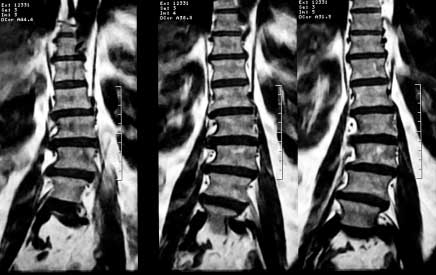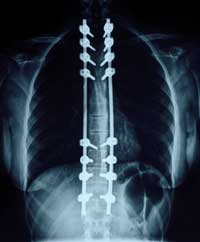Condition and Causes
Scoliosis occurs when the spine curves abnormally in one or more places. These curves may affect balance and alignment in the body, and can limit a person’s ability to move normally.
Two percent of people are affected by this deformation of the spine, which frequently develops before puberty. It can be hereditary, or it can occur due to one of several causes:
Congenital: Existing from birth
Myopathic: The muscles around the spine do not work properly due to muscular or neuromuscular disease, like cerebral palsy or muscular dystrophy.
Ideopathic: Arising spontaneously, or from an obscure or unknown cause
Paralytic: The vertebrae in the spine may become unbalanced when the muscles around the spine no longer work due to spinal cord injury
Symptoms and Diagnosis
When scoliosis is present, several signs occur. These include uneven shoulders, shoulder blade protrusion, uneven waist or elevated hip.
A diagnosis can be confirmed using diagnostic tools including X-rays, Computed Tomography (CT) and Magnetic Resonance Imaging (MRI). The Cobb Method can be used to measure the extent a curve has progressed. This method categorizes in terms of degrees. A curve is viewed as significant if it is greater than 25 to 30 degrees. Forty-five to 50 degree curves are viewed as severe and usually require more aggressive treatment.
 |
| MRI of Degenerative Scoliosis |
Treatment
 |
| Scoliosis Bracing |
 |
| Scoliosis Surgical Correction |
Most people don’t need treatment. Early detection is important because medical observation can ensure that the curve doesn’t worsen. If intervention is needed, a brace may prevent curvature, but in some cases, spinal fusion surgery made be needed to straighten and stabilize the spine.
Your doctor may consider spinal surgery if the condition hasn’t responded to any other, more conservative treatment, or if your curve advances to more than 40-50 degrees. Other considerations for spinal surgery to treat scoliosis include progressive neurological changes including weakness, tingling or numbness, or if the deformity has become unbearable for physical or aesthetic reasons.
Risks and benefits
Spine surgery to treat scoliosis is a major ordeal for adults. As age advances, the chance of post-surgical complications increases. Spinal stiffening due to degenerative causes can make realignment and correction difficult. If there is osteoporosis in the patient, attaching the instrumentation required for the procedure may be difficult.
Surgical treatment of scoliosis usually aims to:
- Remove pressure from the spinal cord and nerves
- Reduce the curve as much as possible
- Stop the curve from progressing
- Protect the nerves and spinal cord from further damage
- Allow nerve compression to improve neurological function of the lower extremities in older patients
Failure to take preventive measures for any spinal condition may result in a further aggravated condition. Surgical measures for advanced cases may give relief from extremity pain. The risks involved with surgery are common – infection, blood loss, damage to nerves and spine – and some specific to your treatment. This material is intended to give the patient an overview of surgical procedures and treatments and is not intended to replace the advice and guidance of a physician. Always consult with your doctor about the particular risks and benefits of your treatment.
Disclaimer Statement
All information provided on this website is for information purposes only. Please see a healthcare professional for medical advice. If you are seeking this information in an emergency situation, please call 911 and seek emergency help.
All materials copyright © 2012 VoxMD.com, All Rights Reserved.
